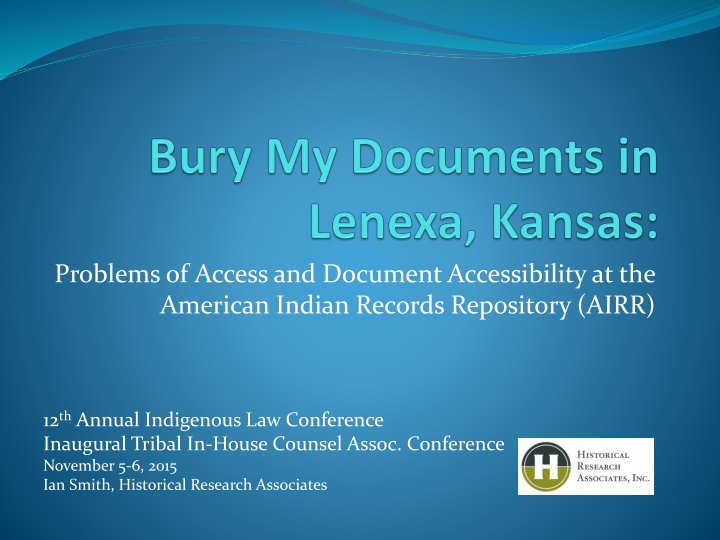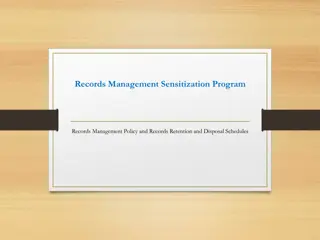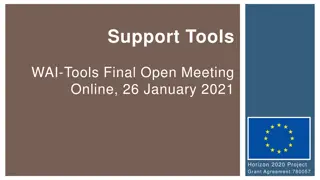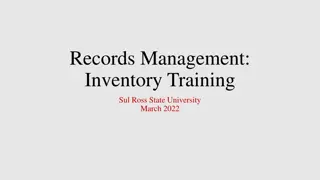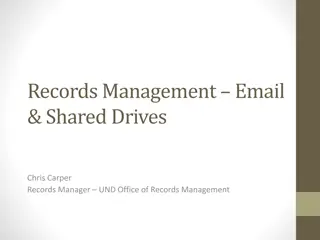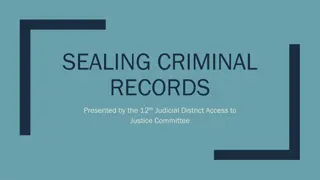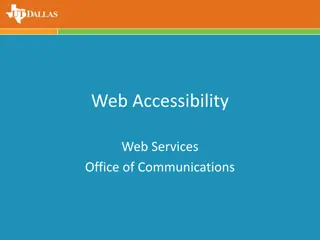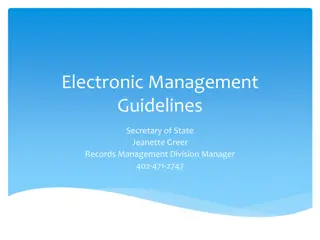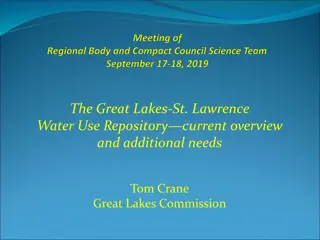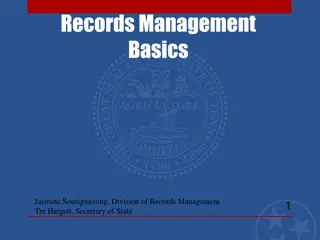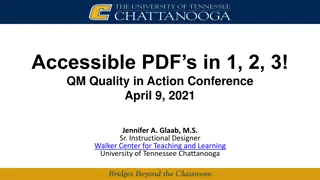Access and Document Accessibility at American Indian Records Repository - Indigenous Law Conference
"Discussing challenges faced in accessing documents at the American Indian Records Repository and promoting better access for the Indigenous community. Key topics include improving tribal in-house counsel associations.
Download Presentation

Please find below an Image/Link to download the presentation.
The content on the website is provided AS IS for your information and personal use only. It may not be sold, licensed, or shared on other websites without obtaining consent from the author.If you encounter any issues during the download, it is possible that the publisher has removed the file from their server.
You are allowed to download the files provided on this website for personal or commercial use, subject to the condition that they are used lawfully. All files are the property of their respective owners.
The content on the website is provided AS IS for your information and personal use only. It may not be sold, licensed, or shared on other websites without obtaining consent from the author.
E N D
Presentation Transcript
Problems of Access and Document Accessibility at the American Indian Records Repository (AIRR) 12th Annual Indigenous Law Conference Inaugural Tribal In-House Counsel Assoc. Conference November 5-6, 2015 Ian Smith, Historical Research Associates
Creation of the AIRR 1992: House report, Misplaced Trust, documented the BIA s ongoing failure to fulfill its fiduciary duties to Indian Tribes, partly due to inadequate record keeping. Misplaced Trust was largely a compendium of earlier critiques levied by GAO, Congress, BIA audits, etc. 1994: Congress enacted the American Indian Trust Fund Management Reform Act, creating the Office of the Special Trustee for American Indians (OST). OST directed to implement all reforms necessary for the proper discharge of the Secretary s trust responsibilities to Indian tribes and individual Indians.
Creation of the AIRR (contd) 1997: OST issued strategic plan to implement reforms mandated by the 1994 Act. One of 13 subprojects called for developing a Records Management solution for Interior trust records to address storage, access, control and disposition. DOI s 1998 High Level Implementation Plan expanded on the OST s Records Management subproject. Cobell v. Babbitt lawsuit further shined a spotlight on the BIA s inadequate record keeping, indicating that the agency had mismanaged individual Indian trust accounts, as well as having destroyed records bearing upon their breaches of trust.
Creation of the AIRR (contd) Sept. 2003: DOI/OST and the National Archives signed a Memorandum of Understanding (MOU) requiring the consolidation of all inactive Indian records held by the BIA and OST at the AIRR. MOU stipulated that the AIRR maintain separate collections for each Tribe. May 2004: AIRR opened with an initial shipment of 94,000 boxes from temporary storage in MO/KS/NM. By 2012, more than 200,000 indexed boxes were housed at AIRR, with roughly 14,000 more arriving annually. Office of Trust Records (OTR), an arm of OST, operates the AIRR in conjunction with NARA.
Pre-AIRR Records Disposition Most BIA records now housed at the AIRR previously would have been accessioned into the permanent collections of the National Archives (NARA). Pre-2000, before becoming NARA property, inactive BIA records first were transferred to Federal Records Centers (FRCs) across the country. FRCs usually co-located with NARA branches. While at FRCs, records remained under the custody and control of the BIA. Access to records at FRCs required BIA permission, but generally could be accessed and researched by public.
Pre-AIRR Records Disposition After a set period of years (established by BIA records disposition schedules), inactive records would be permanently accessioned into NARA facilities, thereby becoming NARA property. Once at NARA, trained archivists would organize records and create finding aids to facilitate research. With some exceptions, NARA records are generally open to the public for research. Until 2000, BIA followed this records disposition protocol, along with other federal agencies.
Pre-AIRR Records Disposition Change began in 2000, when OST, in partnership with NARA, started moving inactive BIA records to temporary storage at Lee s Summit, MO; Overland Park, KS; and Albuquerque, NM. Upon AIRR s opening in May 2004, all of these records (94,000 boxes) were moved to the AIRR. Additional inactive BIA records arrived from FRCs and BIA agency/regional offices across the country. By end of 2006, 150,000 indexed boxes containing an estimated 400 million pages were housed at AIRR. This number increased to 200,000+ boxes by 2012, with about 14,000 more arriving annually from BIA offices.
Fundamental Impacts of AIRR BIA records no longer transferred to NARA or to FRCs. Records held at NARA prior to the AIRR s creation remained property of NARA and are still available there. Due to AIRR s creation, NARA records relating to Indian issues generally extend only into the 1970s. The vast majority of post-1970 BIA records are now housed at the AIRR. Unlike NARA facilities (or FRCs, where research could occur with permission by BIA), the AIRR is not open to the public. Tribes, attorneys, and historians generally cannot conduct in-person research at the AIRR absent active litigation.
Problems Researching at AIRR Inadequacies of the Box Index Search System (BISS) The BISS, or the abyss ? BISS is effectively a file-level database, thus its value is limited by the file-label information within each box. File titles (especially for boxes delivered during AIRR s first 5+ years) often provide only cryptic information or, worse yet, nothing at all. Note: BIA officials have indicated that this may be improving with new file-naming protocols established by OTR. Querying the BISS typically results in a massive number of boxes that may or may not contain relevant records.
Problems Researching at AIRR In short, the tools created by OTR to facilitate research at the AIRR are much less helpful than finding aids produced at NARA facilities. In addition to creating valuable finding aids, NARA staff also previously culled duplicate documents and reorganized files received from BIA. At the AIRR, this kind of culling and organization does not occur, resulting in boxes that sometimes contain a mishmash of highly disorganized materials. In one notable instance, a colleague encountered a box containing what appeared to be the contents of an emptied office drawer, stapler and paperclips included.
Inability to Access the AIRR HRA s in-person AIRR research has occurred only when we have been working under contract with the federal government (e.g., DOJ, DOI). Conversely, no access granted when requesting AIRR research while under contract with Tribes. In one case, OTR stymied a colleague s research in 1960s-1970s tribal census records by requiring submittal of a FOIA request. While this FOIA request yielded a handful of records, none shed any new light on the topic and it is likely that additional records are available at the AIRR.
Inability to Access the AIRR In a second case, a tribe for whom I was conducting research for potential water rights litigation was also denied in-person access to the AIRR s records. Case involved WWII-era dam and subsequent issues extending into the 1970s and beyond. Again, OTR only allowed access via FOIA request. FOIA request produced zero responsive boxes. However, based on research at the BIA agency, we knew that relevant records had been sent to the AIRR. Ultimately, the Tribe was able to access these records by working with BIA staff to obtain copies from the AIRR.
Inability to Access the AIRR Relying on the FOIA process rather than conducting in-person research poses significant problems. OTR employees conducting FOIA searches lack Tribe- specific and case-specific knowledge, which limits their ability to identify potentially relevant materials. Historians and attorneys use their in-depth knowledge about a Tribe/lawsuit to find relevant documents that may appear off-topic to others e.g., understanding a Tribe s BIA jurisdictional history. Research by FOIA disallows the kind of flexibility and detective work that historians and other researchers rely on to locate pertinent documents.
Access Issues Pose Future Problems Lack of public access to the AIRR hinders post-1970s scholarship in Indian history, e.g., studies of: Cobell and related mismanagement lawsuits Indian gaming and fee-to-trust issues Impacts of self-governance and 638 contracting Lack of access at the AIRR could also limit the ability to identify future mismanagement claims. Records dealing with a wide range of federal trust responsibilities are housed at AIRR, e.g., leases, permits, timber contracts, ROW easements, etc. Such documents could form the basis for future mismanagement lawsuits.
Concluding Thoughts AIRR as (yet another) well-intentioned government policy that has failed to fulfill expectations. Problems at AIRR underscore the need for Tribes to adopt and implement their own archival/records management policies and procedures. One of Venus s top ten lessons learned. Invaluable for Tribes to be able to document and access their own history. Due to difficulty accessing AIRR records, I encourage Tribes and BIA to avoid sending documents to the cave, if at all possible.
Thank you! Ian Smith, Historical Research Associates ismith@hrassoc.com For more info re: AIRR, see The Public Historian, vol. 37, no. 1 (2015): 39-45.
